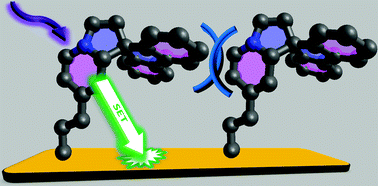Solid state and surface effects in thin-film molecular switches†
Abstract
Thin-films of three dihydroindolizine molecular switches were monitored via polarization modulation infrared reflection absorption spectroscopy to quantify solid state and surface-based inhibition of switching as a function of irradiation time. In the solid state, the molecular switches diverged dramatically with flexible alkyl substituents resulting in switching rates up to three times that of switches containing rigid analogs. For thin-films, decreasing film thickness from 30 nm to approximately 4 molecules thick resulted in an increase in inhibition. This was found to be consistent across all molecules regardless of structure. Increased inhibition is isolated as a metal/molecule interaction, and its consistency across structure is suggestive of energy transfer to the surface. These molecular switches highlight the interplay between molecular design, electronic structure, and switching efficiency.



 Please wait while we load your content...
Please wait while we load your content...